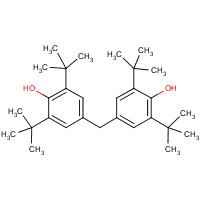4,4'-Methylenebis(2,6-di-tert-butylphenol)
Agent Name
4,4'-Methylenebis(2,6-di-tert-butylphenol)
CAS Number
118-82-1
Formula
C29-H44-O2
Major Category
Other Classes

Synonyms
2,2',6,6'-Tetra-tert-butyl-4,4'-methylenediphenol; 4,4'-Methylenebis(2,6-bis(1,1-dimethylethyl)phenol); 4,4'-Methylenebis(2,6-di-t-butylphenol); Antioxidant E 702; Binox M; Di(4-hydroxy-3,5-di-tert-butylphenyl)methane; E 702; Ethyl 702; Etil 702; Ionox 220; Ionox 220 Antioxidant; L 3MB1; LZ-MB 1; MB 1 (Antioxidant); MB 1 (antioxidant) (VAN); Phenol, 4,4'-methylenebis(2,6-di-tert-butyl-; Phenol, 4,4'-methylenebis(2,6-bis(1,1-dimethylethyl)-; [ChemIDplus] 4,4'-Dihydroxy-3,3',5,5'-tetra-tert-butyl-diphenylmethan; Alkylated phenol; Ethanox 702; [IUCLID]
Category
Other Aromatic Compounds
Description
White or yellow powder; [Alfa Aesar MSDS]
Sources/Uses
Used in the fuel, polymers, and lubricant blending industries; Used as an antioxidant additive in petroleum-based lubricants; [IUCLID]
Comments
A skin and eye irritant in rabbits; No mortality or gross lesions observed in oral lethal-dose study of rats at 5,000 mg/kg; Another lethal-dose study of rats produced increasing severity of hepatic degeneration in animals that died (doses of 4,700-36,000 mg/kg); No mortality or symptoms of systemic toxicity observed in dermal lethal-dose study of rats at doses up to 36,000 mg/kg; [IUCLID] Causes ulceration or bleeding from the large intestine and fibrous hepatitis (cirrhosis, post necrotic scarring) in 2-year constant feeding studies of dogs; [RTECS] A skin and strong eye irritant; [Alfa Aesar MSDS] See "2,2'-Methylenebis(6-t-butyl-4-ethylphenol)."
Biomedical References
Exposure Assessment
Adverse Effects
Hepatotoxin
Hepatoxic (a) from occupational exposure (secondary effect) or (b) in animal studies or in humans after ingestion
Diseases, Processes, and Activities Linked to This Agent
Other Information
No other related information on this agent was found.